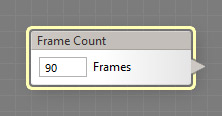
The Frame Count component outputs an HDR value representing the number of frames in the animation. The output value does not change depending on the current Timeline position or on the number of the frame that is currently being rendered. Frame Count is most useful when you need your image to be processed in a different way depending on the current frame.
Frame Count is a numeric component, it can be located in the Animation category on the Components Bar. When Frame Count is present on the canvas, even if not connected to any component, the filter is considered to be an animated filter.
All copies of Frame Count in a filter have the same output value. When the filter is used in an animated artboard, the actual frame count supplied by the artboard overrides the output value of this component.
Number of Frames
Defines the value that goes to the target inputs. The value must be a positive integer between 1 and 999999. The target inputs interpret the Number of Frames value differently, depending on their type. The way Number of Frames is passed to each target input can be fine-tuned with Remappers – see Use Remapping below for details. When Use Remapping is turned off (or when the remapper is set to its default settings), Number of Frames is passed as follows:
- To Slider inputs: the resulting value of the target slider is determined by a linear interpolation between its minimum and maximum values, where the interpolation coefficient is defined by the output value of Number of Frames.
- To HDR Color inputs: the RGB channel values of the color assume the same values as the output value of Number of Frames.
- To LDR Color inputs: the resulting color is determined by a linear interpolation between black and white, where the interpolation coefficient is defined by the output value of Number of Frames.
- To Angle inputs: the range of 0 to 1 is proportionally mapped onto the degree range of 0 to 360. Values beyond the range of 0 to 1 are wrapped back into this range before being mapped onto the range of 0 to 360 and sent to the target input.
- To IntSlider inputs: the resulting value of the target integer slider is determined by a linear interpolation between its minimum and maximum values, where the interpolation coefficient is defined by the output value of Number of Frames.
- To List inputs: the item number in the target list is determined by a linear interpolation between 1 and the item count of the list, where the interpolation coefficient is defined by the output value of Number of Frames.
- To Checkbox inputs: if the output value of Number of Frames is greater than 0.5, the target checkbox becomes 'checked', otherwise it stays 'unchecked'.
- To Value inputs: the output value of Number of Frames is passed to the target input unchanged.
Use Remapping
When turned on, enables Remappers for all connections of Number of Frames to its target inputs. Remappers allow you to specify how Number of Frames affects the resulting value of each target input.